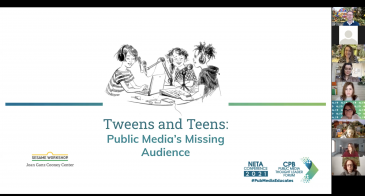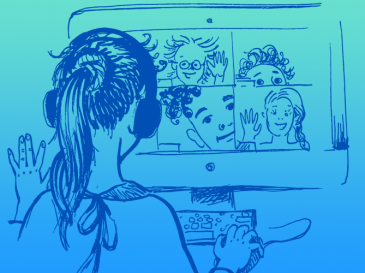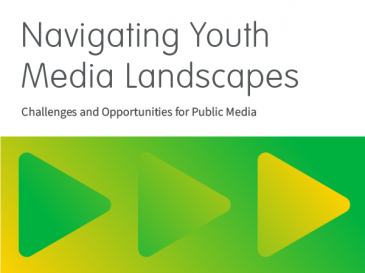Tweens and Teens: Public Media’s Missing Audience at NETA 2021 Annual Conference
March 17, 2021
On January 26, 2021, the Cooney Center’s Executive Director Michael Preston and Senior Fellows Monica Bulger, Mary Madden, and Rafi Santo presented a session called Tweens and Teens: Public Media’s Missing Audience at the 2021 National Educational Telecommunications Association (NETA) Conference and CPB Public Media Thought Leader Forum. The goal of the session was to share findings from our latest research on tweens and teens and their media habits, as well as ideas and opportunities for public media to serve this “missing middle” audience. But we also took the opportunity to highlight some of the incredible work local stations are doing to engage youth audiences, featuring Maribel Lopez, Director of ReWire, who spoke about the youth-focused work she is doing at Twin Cities PBS.
Media is more than “just” entertainment

Tweens and Teens: Public Media’s Missing Audience at NETA 2021 Annual Conference and CPB Thought Leader Forum
During the fall of 2020, Mary and Monica worked with youth-focused organizations around the country to assemble focus groups of diverse youth between 10 and 17 years old.
Mary pointed out that these focus groups provided an opportunity to “hear from kids themselves in their own voices [about] how they spend their free time, what they find interesting, how they make their choices about what to do, what platforms they choose, who they spend their time with—and then really understand what issues are important to them, and in their own words, understand why.”
Across all of the focus groups, they heard a lot about video. Whether kids are using social media, watching shows, or sharing TikToks, they are using video to communicate, creating their own, or consuming it across various platforms.
The researchers were struck by the popularity of how-to and advice videos. ”We’re seeing a lot [of young people] seeking out videos to support [their] interest in learning new skills during this time, finding answers to things that they don’t necessarily want to talk about with parents and peers, and also to support a lot of learning and offline interest to augment their interest in doing activities that have nothing to do with the Internet,” said Mary. “Kids are crafting, embroidering, learning art skills, tricks and tips from Instagram, YouTube, and TikTok. The kids we spoke to are such creative young people, and we find that that’s a really exciting space for us to think about in the role of public media moving forward.”
How do young people see “public media?
Monica explained that the term “public media” is not one most young people are aware of, but when reminded of specific shows like Sesame Street, the youth they spoke to “had positive memories.” Although most of the participants they spoke with weren’t currently watching programming on public media now, Monica and Mary asked them to take a guess at what they thought the idea could mean.
These conversations revealed that many young people “didn’t really understand ‘free’, in the context of public media versus YouTube or TikTok. They couldn’t distinguish between ‘you’re the product’ versus ‘public goods’. There was a lot of assuming that anything that was free had ads or that public media was the same kind of thing as TikTok.” That said, Monica also recalled how one student who had watched The Social Dilemma cited the phrase, “If the product is free, you’re the product.”
“So there is a possibility of teaching the difference between a commercial and public good,” Monica continued. This could mean there is value in explaining public media’s role in society “like a library or public education, versus something that is free but is collecting your data or has commercial interests.”
A path for public media
Rafi Santo then spoke about how the Next Gen project has been reaching out to stations to start the process of building up the capacity of public media organizations to serve youth audiences.
Over the summer, the Cooney Center and CPB ran a series of design sprints with more than 50 public media practitioners to get their input on three vital questions when it comes to youth and public media:
- What are we building on, and where are we starting from?
- Where are we going, and what’s our north star?
- How do we get there? How do we build a network to drive this work forward?
Many of the participants of the design sprints were already engaged in youth-facing programs, and there was representation from stations of all shapes and sizes across the country. Participants drew on their experiences running a wide variety of programs ranging from direct services for young people, like station-led educational programs or job placement and training, serving youth through partners by making curricula and teaching materials for schools and libraries, and producing media for a youth audience. You can read about some of these projects on our blog.
We asked these public media practitioners to reflect on the core values that drive their work, synthesizing them into a list that included goals like advancing media literacy, or youth economic mobility and career readiness, youth developmental health and uplift, deepening youth perspectives, promoting justice, reducing inequities, and changing the face of public media workers. This feedback and more like it is being incorporated into the Next Gen project to make sure it reflects the needs of public media.
Next Gen in a local context
Rafi highlighted that point that we heard often from the public media community was that “in order for this work to go forward, this needs to be a priority at the strategic level within stations,” and that the project needed to be applicable to the “incredible diversity of stations.” Maribel Lopez picked up on this theme when she described the ways she had shared her experiences with the Next Gen project with her colleagues at Twin Cities PBS (TPT).
First, she explained that although the programs she works on – ReWire and Sound Field – are by and for young adults, she sees a lot of overlap with teen and tween audiences. Young adults are “generally folks who are navigating all of the firsts that are thrown their way in early adulthood. It’s a historically underserved and untapped audience for public media, and it’s also one that is younger than the general broadcast viewer.”
After participating in the design sprints, Maribel was encouraged to brief TPT’s leadership team on what she had learned. Since then, she has continued to follow the initiative, reading the Navigating Youth Media Landscapes report, highlighting the things that really spoke to her, and “the things that seemed possible for us to really take and run with at TPT” sharing those points back with the leadership team.
“We really are committed to engaging with younger audiences,” Maribel said, “and that is a vast group of people. But we also want to do it better and we want to do it more effectively. Sharing all of this information, it ultimately is going to make our work stronger. And really, I think the folks at NextGen Public Media are doing a lot of the heavy lifting. [Then] it’s up to us as member stations to take it back and see what works, what’s going to strengthen some of what we’re doing, and what are maybe some new and exciting things.”
If you would like to stay updated on our work connecting teens and tweens to public media, please sign up for our newsletter and follow our social media for updates. And in the meantime, please take a look at our blog to learn more about the work stations are doing to engage young people across the country.



